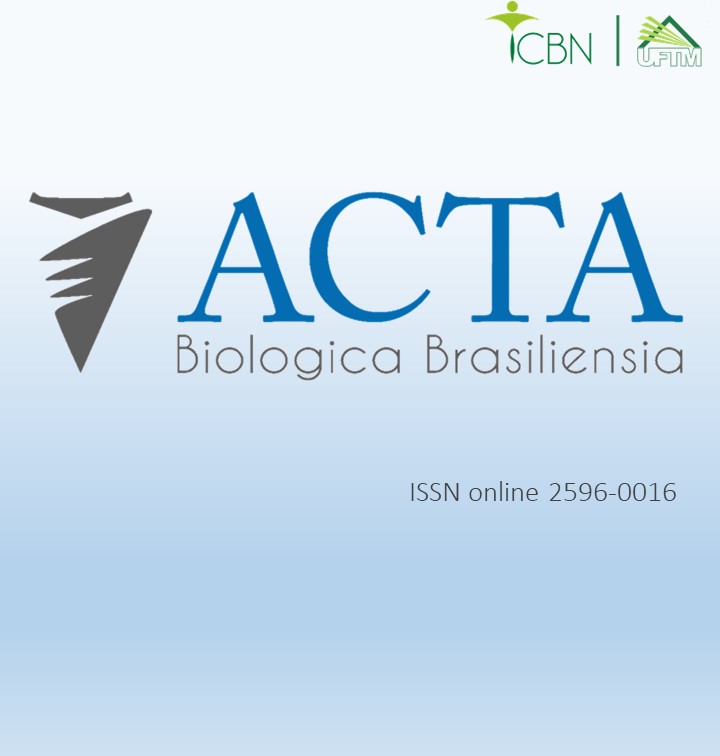TAXONOMIC SURVEY OF THE FRESHWATER MICROALGAE IN THE REGION OF INSTITUTO FEDERAL GOIANO – CAMPUS CERES
DOI:
https://doi.org/10.18554/acbiobras.v7i1.7652Keywords:
aquatic ecosystem, phytoplankton, taxonomyAbstract
Microalgae are organisms that play an important role in the stability of aquatic ecosystems, serving not only as the foundation of the food chain in aquatic environments but also contributing significantly to the oxygen available in the Earth's atmosphere. Despite the high diversity of freshwater microalgae, there is a scarcity of comprehensive taxonomic studies on these organisms. Therefore, the objective of this study was to conduct a taxonomic survey of freshwater microalgae in two watercourses that run through the region of the Federal Institute Goiano - Campus Ceres. Collections and identification of morphological characters were carried out in a laboratory setting to assess the diversity of phytoplankton. Sampling was performed using periphytic, metaphytic, and planktonic algae. Collections were made at ten points along the two sample streams over two consecutive months. Identification was conducted using an optical microscope, with support from specialized literature. A total of 25 taxa were identified, distributed across 6 classes, 12 orders, 18 families, and 24 genera, belonging to the divisions Bacillariophyta, Charophyta, Chlorophyta, Cyanophyta, Euglenophyta, and Heterokontophyta. The results obtained indicate significant phycological representation in the region, which will serve as a basis for future studies in the area, still relatively few in the Cerrado region.
References
Raven PH, Evert RF, Eichhorn SE. Biologia vegetal. 6ª ed. Rio de Janeiro, Guanabara Koogan; 2008.
Reviers B. Biologia e filogenia das algas. 1ª ed. Porto Alegre, Artmed; 2006.
Rocha O. Águas doces. Avaliação do estado do conhecimento da diversidade biológica do Brasil. Ministério do Meio Ambiente; 2003.
Lee RE. Phycology. 4ª ed. Cambridge University Press, New York; 2008.
Alvarez N, Penna EJ. Alternativas no monitoreo de calidad de aguas: algas como biodindicadores. Acta Nova. 2004; 2(4): 513-517. http://www.scielo.org.bo/scielo.php?script=sci_arttext&pid=S1683-07892004000100007.
Goldsborough LG, Robinson GGC. Pattern in wetlands. In: Stevenson RJ, Bothwell ML, Lowe RL (Eds). Algal Ecology: freshwater benthic ecosystems. Academic Press, San Diego, 1996; 77-117.
Lanari M. Variabilidade sazonal da estrutura da comunidade de microalgas no infralitoral da Ilha do Arvoredo. Rebiomar do Arvoredo. PROJETO ALGAS MARINHAS DA ILHA DO ARVOREDO. Fundação Universidade Federal do Rio Grande do Norte (FURG). 2006.
Lawrence GH. Taxonomia das plantas vasculares. Fundação Calouste Gulbenkian; 1973.
Senna PAC, Magrin AGE. A importância da “boa” identificação dos organismos fitoplanctônicos para os estudos ecológicos. Perspectivas da Limnologia no Brasil. Gráfica e Editora União; 1999.
Mayr E. Systematics and the origin of species, from de viewpoint of a zoologist. 7ª ed. Harvard University Press; 1942.
Krienitz L, Bock C. Present state of the systematics of planktonic coccoid green algae of inland waters. Hydrobiologia. 2012; 698(1): 295-326. https://link.springer.com/article/10.1007/s10750-012-1079-z.
Lourenço SO. Cultivo de microalgas marinhas: princípios e aplicações. São Carlos, Rima Editora; 2006.
Bicudo MEC, Menezes M. Gêneros de algas de águas continentais do Brasil. 3ª ed. São Paulo, Rima Editora; 2017.
Tucci A, Sant’Anna CL, Azevedo MTP, Malone CFS, Werner VR, Rosini EF, Gama WA, Hentschke GS, Osti JAS, Dias AS, Jacinavicius FR, Santos KRS. Atlas de cianobactérias e microalgas de águas continentais brasileiras. 2ª ed. São Paulo, Instituto de Botânica; 2019.
AlgaeBase. 2023. https://www.algaebase.org/search/species/detail/?species_id=27370.
Magurran AE. Measuring Biological Diversity. Blackwell Science, Oxford; 2004.
Graham LE, Wilcox LW. Algae. Prentice-Hall, Upper Saddle River; 2000.
Coesel PFM, Krienitz L. Diversity and Geographic distribution of desmids and other coccoid green algae. Biodiversity and Conservation. 2008; 17: 381– 392. https://link.springer.com/article/10.1007/s10531-007-9256-5.
Round FE. Biologia das Algas. Ed. Guanabara Dois, Rio de Janeiro; 1983.
Felisberto SA, Rodrigues L. Influência do gradiente longitudinal (rio- barragem) na similaridade das comunidades de desmídias perifíticas. Revista Brasileira de Botânica. 2005; 28: 241-254. https://www.scielo.br/j/rbb/a/GNnn3JwGWtmxn7D55yZrmsy/?lang=pt&format=pdf.
Moura LCS, Santos SS, Souza CA, Santos CRA, Bortolini JC. Phytoplankton richness and abundance in response to seasonality and spatiality in a tropical reservoir. Acta Limnol. Bras. 2021; 33: 1-12. https://www.scielo.br/j/alb/a/NNybhsPkgvpCkYKPXz7GTxJ/.
Calijuri MC, Alves MSA, Santos ACA. Cianobactérias e cianotoxinas em águas continentais. [S.1: s.n.]; 2006.
Dunck B, Felisberto SA, Nogueira IS. Effects of freshwater eutrophication on species and functional beta diversity of periphytic algae. Hydrobiologia. 2019; 837: 195–204. https://link.springer.com/article/10.1007/s10750-019-03971-x.
Dunck B, Nogueira IS, Felisberto SA. Composição e diversidade de algas perifíticas em veredas sob diferentes impactos antrópicos (Goiás, Brasil). Iheringia. 2013; 68(2): 237-248. https://isb.emnuvens.com.br/iheringia/article/view/22.
Nogueira IS, Leandro-Rodrigues NC. Algas planctônicas de um lago artificial do Jardim Botânico Chico Mendes, Goiânia, Goiás: florística e algumas considerações ecológicas. Ver. Brasil. Biol. 1999; 59(3): 377-395. https://www.scielo.br/j/rbbio/a/M4tdhpYtRQBqmQpyyYn3c7B/.
Hillebrand H, Sommer U. Diversity of benthic microalgae in response to colonization time and eutrophication. Aquatic Botany. 2000; 67: 221-223. https://www.sciencedirect.com/science/article/pii/S0304377000000887.
Worm B, Lotze HK, Bostrom C, Engkvist R, Labanauskas V, Sommer U. Marine diversity shift linked to interactions among grazers, nutrientes and propagule banks. Marine Ecology-Progress Series. 1999; 185: 309–314. https://www.int-res.com/articles/meps/185/m185p309.pdf.
Inmet – Instituto Nacional de Meteorologia, Brasília, DF, Brasil. https://www.gov.br/agricultura/ptbr/assuntos/inmet?r=tempo2/mapasPrecipitacao
Cetto JM, Leandrini JA, Felisberto SA, Rodrigues L. Comunidade de algas perifíticas no reservatório de Irai, Estado do Paraná, Brasil. Acta Scientiarum. Biological Sciences. 2004; 26(1): 1-7. file:///C:/Users/usuario/Downloads/1645-Texto%20do%20artigo-4382-1-10-20080401.pdf.
Nogueira IS, Nabout JC, Oliveira JE, Silva KM. Diversidade (alfa, beta e gama) da comunidade fitoplanctônica de quatro lagos artificiais urbanos do município de Goiânia, GO. Hoehnea. 2008; 35(2): 219-233. https://www.scielo.br/j/hoehnea/a/vm4mmKt3FGLb9zpTSz6SW9D/?lang=pt.





